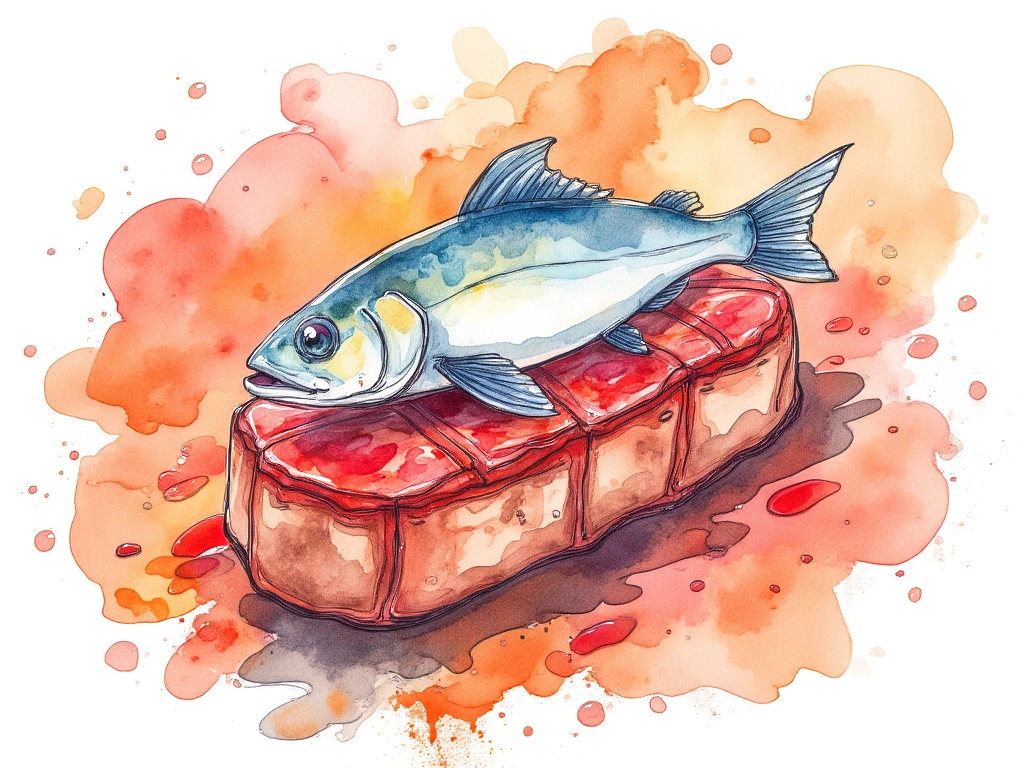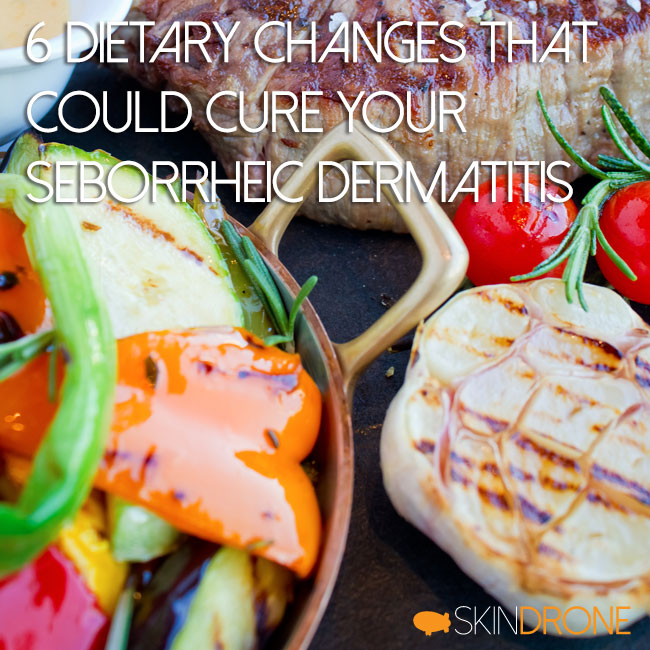- Diet and Seborrheic Dermatitis: Many find dietary changes helpful in managing symptoms.
- Omega-6 Reduction: Limiting vegetable oils high in omega-6 fatty acids may reduce flare-ups.
- White Flour Elimination: Removing white flour and baked goods can improve digestion and skin health.
- Sugar and Fat Control: Reducing high-fat, high-sugar foods may decrease inflammation.
- Vitamin D Importance: Ensuring adequate vitamin D intake, potentially through food sources like sardines, is crucial.
- Probiotic-Rich Foods: Yogurt, kefir, and fermented foods can support gut health and skin resilience.
Reports of individuals improving their seborrheic dermatitis symptoms through diet alone are widespread. This article summarizes common dietary recommendations and explores their potential benefits.
While this article focuses on simple dietary changes, for comprehensive diet plans, you might find our previous review of 5 specific seborrheic dermatitis-friendly diet plans insightful.
Key Dietary Considerations Discussed:
- Caffeine: While often blamed for flare-ups, evidence is limited, and hot beverages in general might be a factor.
- Probiotics: Increasing probiotic-rich foods like yogurt and kefir can enhance digestive health and skin resilience.
- Omega-3 to Omega-6 Ratio: Improving this balance may reduce overall inflammation and flare-up severity.
- Refined Carbohydrates: Cutting these can improve digestion and potentially reduce sebum production.
- Combined Fat and Sugar: Consuming fat and sugar together might increase sugar fermentation and systemic inflammation.
- Grains: Some individuals find grains exacerbate their seborrheic dermatitis.
- Vitamin D: Low vitamin D levels are common in seborrheic dermatitis sufferers, though supplementation isn’t always the answer – more details in: The Potential Connection Between Seborrheic Dermatitis and Vitamin D.
Your Questions are Welcome!
This overview is based on extensive online research. If you’d like references for any information, please ask in the comments!

1. Reduce or Eliminate Omega-6 Fatty Acids
Omega-6 fatty acids are prevalent in commonly used vegetable oils. Many people have reported significant improvements by simply reducing or eliminating these oils from their diet. While olive oil is low in Omega-6, some individuals with seborrheic dermatitis advise against it due to a possible link between oleic acid and the condition.
Common culprits high in omega-6s include vegetable oils, salad dressings, and dips. Consider replacing these with alternatives like yogurt (which also offers probiotics, as discussed in point 9) and observe your skin’s reaction.

2. Eliminate White Flour and Baked Goods
This is a frequently discussed dietary change among those seeking to manage seborrheic dermatitis through diet. Removing white flour and baked products can significantly improve digestive function. This digestive boost is believed to be a primary reason for the positive skin changes observed.
Personally, addressing white flour intake was a crucial step in managing my seborrheic dermatitis. While complete avoidance isn’t always necessary long-term, experimenting with eliminating or reducing these foods is highly recommended to see how it impacts your skin condition.


3. Limit High-Fat, High-Sugar Foods
Modern diets often include a high proportion of high-fat, high-sugar foods. This dietary pattern, popularized with the rise of tea and coffee houses in the 17th century, has been linked to various health issues.
The combination of high fat and sugar can slow down digestion, allowing sugar to ferment in the digestive tract. This creates an environment that may encourage the overgrowth of internal yeasts and fungi, potentially increasing systemic inflammation. This effect can be amplified if the body is already under stress.
Reducing or eliminating high-fat, high-sugar foods can improve digestion and allow your body’s systems to recover and function more effectively.

4. Consider Grain Elimination
Similar to reducing white flour, eliminating grains is another popular topic in online seborrheic dermatitis discussions. The Paleo diet, popularized by [www.marksdailyapple.com][1], advocates for grain elimination to enhance athletic performance and overall health.
However, it’s important to note that the Paleo diet lacks strong scientific backing, and many medical professionals advise against it.
From personal experience, completely eliminating grains felt restrictive and unsustainable. Focusing solely on protein felt unbalanced and led to feelings of sluggishness and lack of energy.

5. Ensure Adequate Vitamin D Intake
Getting enough Vitamin D is often an overlooked factor in managing seborrheic dermatitis. Low vitamin D levels are common in individuals with this condition, a connection explored in detail in another post (The Potential Connection Between Seborrheic Dermatitis and Vitamin D).
While many try to increase vitamin D with D3 supplements, I found limited benefit from supplements alone.
Instead, I focused on vitamin D-rich foods, particularly spring water sardines. Sardines are packed with calcium, protein, vitamin D, and omega-3s, and are low in sodium. Incorporating sardines into my diet, even a can a day, significantly improved my seborrheic dermatitis. However, maintaining this daily intake long-term became less appealing.
It’s also crucial to remember that the benefits of omega-3s can be negated when consumed with omega-6s, a finding from the University of British Columbia. This may explain why some experience limited benefits from omega-3 supplementation.
More details on this research are available [here][2].

6. Replace Red Meat with Fish
Closely related to the previous point, substituting red meat with fish can dramatically increase your omega-3 fatty acid intake.
Some individuals have also noticed an improvement in seborrheic dermatitis simply by reducing or eliminating red meat. Considering the data on red meat’s impact on health, it’s worth questioning our reliance on it as a dietary staple.
While I still enjoy red meat occasionally, I’ve significantly reduced my consumption, prioritizing foods with higher nutritional value.

7. Optimize Your Eating Habits
How you eat is as important as what you eat for digestion. Do you eat mindfully, chew thoroughly, and eat in a relaxed environment? Or are meals rushed and eaten on the go?
These seemingly small aspects of eating habits significantly impact digestion. While this is a complex topic to delve into deeply here, you can find more information in [this article][3]. Alternatively, request a summary in the comments, and I’ll provide a more detailed explanation.

8. Reduce Coffee/Caffeine Consumption
Many report that reducing caffeine intake can lessen the severity of seborrheic dermatitis flare-ups. While the exact reasons are unclear, improved hydration is often suggested (caffeinated drinks are commonly believed to be dehydrating).
But does reducing caffeine truly improve skin hydration?
Regarding overall hydration, research suggests the dehydrating effect of caffeine is largely a myth [1]. Studies even indicate that caffeine intake doesn’t lead to dehydration during exercise [2].
Further investigation reveals an interesting point:
While coffee (or caffeine alone) may not promote flushing, hot coffee (or hot water) does [3].
Perhaps the perceived link between caffeine and flare-ups is a self-fulfilling prophecy. If we believe coffee is the culprit, a negative placebo effect might be at play.

9. Increase Yogurt/Kefir and Fermented Food Intake
A common theory regarding seborrheic dermatitis is its connection to digestive health. Probiotic-rich foods or supplements are frequently recommended to improve gut health.
Yogurt and kefir, dairy products rich in lactic acid-producing probiotic cultures, are often mentioned. Non-dairy alternatives include kimchi, sauerkraut, or kombucha.
The idea is that increasing fermented food consumption can improve digestive health, leading to better immune function and potentially alleviating seborrheic dermatitis. Whether it’s this straightforward is debated, and solid medical evidence is still lacking. However, some studies show promise in related skin conditions like acne, rosacea, and atopic dermatitis [4, 5, 6, 7, 8].

In Summary
Numerous dietary recommendations exist online for managing seborrheic dermatitis. The nine changes discussed above are among the most popular and have been personally helpful in the past. Ultimately, managing my seborrheic dermatitis involved a holistic approach beyond just diet. Experiment with these suggestions – they might be the dietary adjustments that help you manage your seborrheic dermatitis effectively.
Could Diet Changes Help Your Seborrheic Dermatitis?
Try these changes and share your results in the comments below! If you have other dietary tips for managing seborrheic dermatitis, please comment – your input is welcome!

Hi Michael,
Reply PermalinkI was wondering what do you stand on digestive enzyme supplements. Actually, I live with 4 friends and It is very hard for me to avoid trigger foods every single time, it’s a pain in the arse. It always gives my skin few setbacks. What do you think of this “Top Secret Nutrition: Digestive Enzymes”". I found it on bodybuilding(dot)com with a very high rating. Highly appreciate your suggestion. Thanks
Hi Sultan,
Not sure to be honest. For me they didn’t really work. However, I didn’t try that specific one. These are the ones I tried:
Some actually felt like they made it worse.
In the end it felt like it was a waste of money. Still have most of these laying around somewhere.
Salted, vinegar based and fermented dishes are an excellent source of digestive enzymes. Many cultures make heavy use of them with food traditionally.
Some examples: Germans > Saurkraut, Japan > Miso, Korea > Kimchi. I’m sure these natural products have a significantly greater amount of enzymatic activity.
In terms of trigger foods. What I kind of found was that it wasn’t necessarily avoiding them all together.
It was much more about making sure to focus on the foods I should be eating. If I eat healthy food I enjoy most of the time, the in-between trigger foods don’t seem to be much of an issue.
Hope that helps.
Reply PermalinkHow are things otherwise?
Hey Micheal,
Reply Permalinkhmmm. I have read that papaya and pineapple are also very good for digestion. what do you think ?
My improvements are very much visible now. Reduction in redness and rashes are smaller in size. It’s just that every now and then I eat something which cause redness or sometimes rashes. Burning feelings have almost gone but sometimes I get very slight itching (only due to trigger food). Otherwise, things are much better now.
Recently, I have noticed that my SD on chest is being irritated, any suggestions on this?
Just one question, before treating your SD, did your skin looked aged or any wrinkle problems, and is your facial skin looks normal now?
Hey Sultan,
Yeah, I heard they are good as well. However, I remember I hear something about most Papayas are GMO or something. Pineapples should be good though.
Funny enough, I’m actually currently writing the digestion chapter for the SD book. It’s not ready, but you can check my current chapter outline here: https://goo.gl/Jd3SC6
Regards to that weird feeling, it acted up quite significantly in the past couple days. Not sure exactly why it occurred.
Possible reasons:
Even had a bit of irritation, similar to how it original started, but on the opposite nostril.
However, it has calmed drastically as I have reversed reasons 2-4 above (still writing the book:) )
In terms of the skin ageing and wrinkles, it was never really a problem for me.
However, I never used the hydro-cortisone for more than a week or two when first prescribed.
From much of my research, these seem to be possible side-effects.
You will likely see these issues diminish though. The Restoraderm Moisturiser contains Sodium PCA and Hyaluronic Hcid, which are used it many anti-wrinkle/anti-ageing creams.
For the chest, not sure. Maybe you can try a bit of Sudocrem there.
I’m currently working on my own cream similar to the Restoraderm, but it seems that having several variations is key.
A variation with a higher concentration of moisturising ingredients might be good for the chest as the skin is thicker there.
Will send you a sample if I manage to perfect it (still a bit too greasy).
All the best.
Reply PermalinkHi Micheal,
Reply PermalinkI am really looking forward to your SD book. Digestion chapter looks awesome. I have also noticed that when I am having poor digestion and gas problems I tend to react to even non-trigger foods. Two days ago I eat spicy food and I got the trigger, but surprisingly yesterday I eat spicy food and nothing happened (my stomach was better yesterday and no gas issues).
It’s shocking how you got the trigger just by thinking. My friends sometimes tell me I think about my problems too much, let it go and things will be alright. Well they may be right. Mind over matter, maybe!
I still havent started the glutamine because my initial experience with glutamine wasn’t very good.
Junk food is the ultimate culprit whether it’s acne, SD or ezcema. They all promotes inflammation in the body. Anything heaty for the body is really bad. Do you think this is linked to whether poor digestion or weak immune system?
I hope your SD will go away.
Ahhh, well I stupidly used it for many months every 2 year. The problem is Restoraderm moisturizer caused redness. Do you have any other moisturizer with those ingredients, helpful for both wrinkles and SD? I am considering aveeno daily moisturising lotion, what do you think about this ?
That is so great, I hope you will be successful in creating your own version of restoraderm and I would love to receive a sample.
Best of luck.
Hey Micheal,
Reply PermalinkMost of my diet is cooked food. Which cooking oil would you prefer?
Hey Sultan,
Yeah, poor digestion, stress, weak immune system and seborrheic dermatitis are all interconnect and seem to be part of the same problem.
I’m not sure if it is necessarily all junk food. Pre-packaged food in general (even some of the healthy stuff) often makes us of fat for preservation. Much of this fat is heavily oxidized and there is a bit of research happening in this area.
Basically, my belief is that something in the body is at the very front lines is poor quality sebum production and excessive turn-over of skin cells. The rapid turn-over requires our system to be capable of producing healthy skin cells quickly, however, a healthy cell depends on lipids (fats) for proper formation. So if the lipids in our bodies are either not being broken down properly or poor quality it makes it hard for these healthy cells to form. Thus our body tries to fix things by cranking up immune activity. Short term this is likely no problem, but if the body is consistently challenged with defending our skin mainly through immune activity rather than it’s physical barrier (which mainly depends on healthy cells and lipids) issues are likely to occur. These issues include skin which is more susceptible to bacteria infection.
Personally the Aveeno wasn’t good for me. This cream was the closest thing I could find to what I’m working on. However, I have not tried it myself. Perhaps I’ll order a bottle myself to see what if it is similar.
Also, here’s the working copy of the antioxidant chapter.
Hope I answered everything…
Reply PermalinkAll the best.
Personally I started to use butter more often for cooking. A part from this, olive oil for lower temperatures.
If you want really go into detail here is a good article.
Lot’s of people recommend coconut oil or peanut oil, but I find they change the taste of the food.
Main things to look for in a good cooking oil:
Another interesting point:
In France and Belgium, it is actually forbidden by law to use frying oils with more than 2% of linolenic acid.
Also one oil I really liked was Macadamia Nut Oi. But it’s quite expensive at the local stores for some reason.
Reply PermalinkLast time I ordered it from US Amaozon and it was around ~$8 for about 500ml. Was actually going to order more, but this is the cheapest one at the moment on there.
Hi Micheal,
Reply PermalinkI can’t use butter. I am allergic to casein protein. I’ll give it a try to coconut oil.
Also, I am unable to login, it says “You are temporarily locked out”.
Hi Sultan,
Sorry for the troubles. The website get’s bombarded with bots, so the login security is fairly strict. I’ve gone ahead and manually unblocked you.
Let me know if you still have issues.
As for the oil, see if you have macadamia nut oil in your area. I liked it more than coconut.
Reply PermalinkSo what cooking oils do you recommend?
Reply PermalinkHi Betty,
This exact question was actually asked my another commenter. You can find the discussion here. Hopefully that helps. Let me know if you need any more details.
All the best.
Reply PermalinkThank you for this guide! I’ve read both your outlines you linked to in your comments. I love what you’re doing here. I’m a long time sufferer and use acv and coconut oil topically, along with totally changing my diet (I follow the Specific Carbohydrate Diet). I’m also trying infusing acv with sage rosemary and basil, and making my own rosemary oil for topical use.
Reply PermalinkHi Ruth,
Thanks for the positive feedback, it’s like comments like this that have been driving my research.
A new chapter is currently in the makings and I’m hoping to basically bring together everything I’ve learnt so far and attempt to provide a comprehensive treatment approach.
Will send out an update to everyone once it is ready.
All the best.
PS. How is your current approach going so far?
Reply PermalinkNioxin shampoo plus Nioxin conditioner scalp therapy. Use this on face and scalp for two weeks. Your itch and flakes will go away work better than prescription shampoos or any other hair products. You will be normal and it does not stink like t-gel or prescription shampoos.
Reply PermalinkAfter a week of Caribbean sunshine, I finally recognized how important Vitamin D can be for my SD. My SD was 95% better after returning home. Now I take 2500IU of D3 and use an OTC 3% salicylic acid shampoo (apply 2x, rinse very well) plus a high quality conditioner. Have stayed at 95% for 2 months with a hope to gain even more ground over the course of 2016. It works and is not an expensive treatment.
Reply PermalinkHi Peter,
Thank you for sharing your experience.
My experience with Vitamin D supplementation was never as favourable.
Hope things continue.
Reply PermalinkBest of luck and look forward to any updates.
I’ve been dealing with the SD on my face for about 3 years. My scalp is fine, not sure how i contracted this. Anyway I’ve googled and tried SO many things. What I’ve learned is that most “cures” do work at least for a while. I remember using ACV when I first attempted to treat this. It was great, cured it right up! I was so excited. Well, I quit using the ACV eventually and the redness/peeling flareup came back. So now the ACV wouldn’t work anymore, on to the next thing, always to have it work for awhile and get all excited thinking its finally cured only to have it come back again. I’ve been revolving solutions for a good couple of years now and like I said most do work but only for a limited amount of time. I’m hoping to delve into internal solutions because this yeast or whatever is HARD TO KILL. HOpefully I’ll figure something out. I’ve already been taking Vit.D and probiotics for many months. I plan to heavily increase my intake of fruits/veggies due to their antioxidant and immunity-boosting effects. Its thought that providing your body with perfect nutrition gives it the ability to cure itself.
Reply PermalinkWhich cooking oil do you use ? Coconut oil is low in Omega 6 but very high in saturated fat (lauric acid). Is it bad for our Seborrheic Dermatitis or our heart health ?
Reply PermalinkI stopped eating all grains over a year ago. The SD on my face cleared up in about 10 ten days. No more creams, itching, and flaking.
Reply Permalink